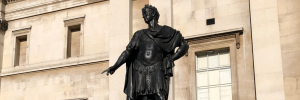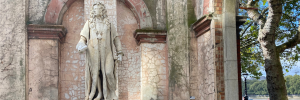Nestled within the heart of the City of London, 7a Laurence Pountney Hill offers a resplendent glimpse into the city’s layered history. What appears as a private residence, flanked by a quaint garden, was once a church, and beneath its floors lies an archaeological treasure trove. This Grade II listed structure was built circa 1670, but its foundations tell an even older story.
Ancient Foundations: Where Roman Meets Medieval
Upon investigating the property, the City of London Archaeology Trust unearthed a fascinating historical overlap. The house’s Medieval wall is constructed on top of an even older Roman wall, dating back to approximately 54 AD. This discovery places 7a Laurence Pountney Hill over one of the most ancient examples of Roman masonry in London, a city already renowned for its deeply rooted history.
St Laurence Pountney: A Church with a Story to Tell
Directly across from 7a stands the site where a church once thrived. Separating the house from this long-gone place of worship is an atmospheric passageway, highlighted in centuries-old maps. The church, St Laurence Pountney, came into existence around the mid-12th century, although historical documents audaciously try to trace its origins back to a land grant from King William I in 1067—a fabrication, but a charming one.
The church’s complex identity included various names such as St Laurence next the Thames and St Laurence in Candlewistrate. The final component of its name, “Pountney,” was added around 1332, thanks to Sir John de Pultneye. A Lord Mayor of London and a member of the Drapers Company, de Pultneye also made a foray into money lending. His philanthropic zeal extended to constructing a chantry chapel within St Laurence Church. Unfortunately, the tomb where he was later buried in Old St Paul’s was obliterated in the Great Fire of London, along with the cathedral itself.
Resilience Through Flames and Time
The Great Fire of 1666 devastated St Laurence Pountney, along with the original house at 7a Laurence Pountney Hill. Though the church was never reconstructed, its parish was amalgamated with that of St Mary Abchurch, which still stands today after being rebuilt by Wren in 1681.
Remarkably, no documentation survives of the rebuilding process for 7a Laurence Pountney Hill, which was overseen by Robert Hooke, one of the City Surveyors at the time. Nevertheless, the house reappears on a 1676 map by J. Ogilby and W. Morgan, confirming its completion by 1675.
The Many Occupants: A Social Tapestry
The house has witnessed a series of interesting tenants. In 1688, Samuel Clay, a merchant, leased the property, and it remained in his family until 1716. Later, it passed to Henry Blunt, whose family left their mark by refurbishing it in line with 18th-century interior trends. By the late 18th century, the property belonged to a Hop Merchant, complete with a pavement trapdoor to facilitate the storage of hop bales.
The 19th-century saw ownership by the L’Anson family. Edward L’Anson Sr. was engaged in London’s sanitation efforts, whereas his son, also named Edward, matured into an accomplished architect, contributing to several Italianate office blocks and even St Bartholomew’s Hospital.
Survival and Transformation
7a Laurence Pountney Hill narrowly escaped destruction during the Second World War, spared by a bomb landing on the opposite side of Laurence Pountney Lane. In 1950, it achieved Grade II listed status. Following multiple refurbishments and stints as office space, it was eventually converted into a private home, selling in 2007 for just under £1 million—a surprisingly modest price for such a historically enriched dwelling in the heart of London.
Through centuries of change, 7a Laurence Pountney Hill stands as a compelling chronicle of London’s multifaceted past, from Roman foundations to modern transformation. One can only wonder what the future holds for this extraordinary site.
Book a private tour with Hazel




